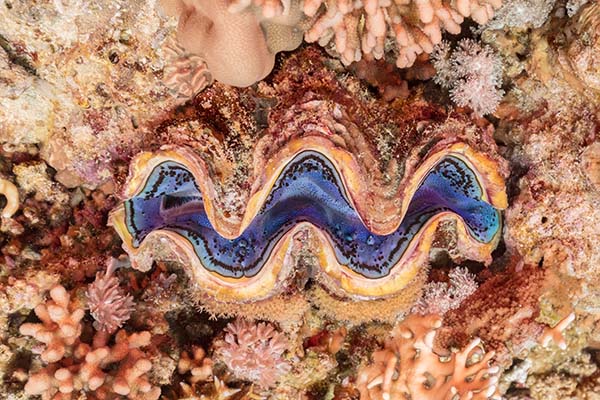The Sun-Powered Giants: Ecology & Importance of Giant Clam (Tridacna spp.) in Marsa Alam
Beneath the shimmering surface of Marsa Alam’s Red Sea, amidst the vibrant coral gardens, lie some of the ocean’s most remarkable solar-powered organisms: the Giant Clams (Tridacna spp.). More than just visually striking, these iconic mollusks are ecological powerhouses, playing a vital, often underestimated, role in the health and productivity of the reef ecosystem. Their unique ability to “farm” sunlight for energy, combined with their filter-feeding capabilities, makes them indispensable components of Marsa Alam’s marine environment. Sambo Divers Marsa Alam is dedicated to exploring and protecting these fascinating “sun-powered giants” and raising awareness about their critical importance.
A Dual Energy Strategy: The Ecology of Tridacna spp.
Giant Clams are truly unique among bivalve mollusks due to their sophisticated symbiotic relationship and dual feeding strategy:
- Primary Energy Source: Symbiotic Algae (Zooxanthellae): The most extraordinary aspect of Tridacna spp. ecology is their reliance on zooxanthellae, microscopic, single-celled algae that live within their mantle tissue. These are the same algae that power most reef-building corals. The clam’s vibrant, often iridescent mantle is designed to maximize light exposure to these algae. The zooxanthellae perform photosynthesis, converting sunlight into sugars and other organic compounds, which are then translocated to the clam. This provides the vast majority (up to 90%) of the clam’s nutritional needs, effectively making them “solar-powered.”
- Secondary Energy Source: Filter Feeding: While primarily fueled by sunlight, Giant Clams are also efficient filter feeders. They draw in seawater through an inhalant siphon, filtering out plankton, detritus, and other suspended organic particles. These particles provide supplementary nutrition, especially important during periods of low light or stress. The processed water is then expelled through an exhalant siphon. This dual feeding strategy makes them highly adaptable and energy-efficient.
- Rapid Calcification and Growth: This efficient energy production from zooxanthellae allows Giant Clams to secrete their massive, calcium carbonate shells at a remarkably fast rate. While they grow slowly in terms of linear expansion, they add significant bulk and weight over time.
- Exceptional Longevity: Giant Clams are incredibly long-lived. While the smaller Tridacna maxima and Tridacna squamosa commonly seen in Marsa Alam can live for decades, the largest species, Tridacna gigas, can live for over 100 years, becoming ancient, stable features of the reef.
- The “Man-Eating Clam” Myth (Debunked): It’s essential to address the pervasive myth of the “man-eating clam.” This is entirely false. Giant Clams close very slowly, primarily as a defense mechanism or in response to changes in light. A diver’s hand or foot cannot be “trapped” by a closing clam. Any perceived danger is a misinterpretation of their natural, slow defensive retraction.
Ecological Importance in Marsa Alam’s Reef Ecosystem
The presence of healthy Giant Clam populations is a sign of a thriving reef and contributes significantly to the Red Sea’s biodiversity:
- Microhabitat Provision: The large, corrugated shells and the surrounding mantle tissue provide unique microhabitats. The crevices and folds of the shell can harbor small invertebrates, algae, and even small fish seeking refuge or foraging opportunities.
- Water Clarity: As highly efficient filter feeders, Tridacna spp. play a role in maintaining water clarity by removing suspended particles from the water column, which benefits other filter feeders and light-dependent corals.
- Nutrient Cycling: Through their feeding and metabolic processes, they contribute to the cycling of nutrients within the reef ecosystem.
- Reef Structure Contribution: While not “building” the reef in the same way as stony corals, their large, fixed shells become integral parts of the reef structure, adding to its stability and complexity over time.
- Biodiversity Hotspot: Their unique symbiotic strategy and the microhabitats they create contribute to the overall biodiversity and resilience of the reef.
Threats and Conservation Challenges in Marsa Alam
Despite their resilience and vital ecological role, Giant Clams face significant global threats, leading to many Tridacna species being listed as vulnerable or endangered:
- Overfishing: Historically, and in some regions currently, giant clams have been heavily harvested for their meat (a delicacy) and their shells (for ornamental purposes or building materials). While harvesting is strictly regulated or prohibited in protected areas like Marsa Alam, illegal poaching remains a concern in some parts of their range.
- Habitat Degradation: Coastal development, pollution (sedimentation, nutrient runoff), and destructive fishing practices can degrade the shallow reef habitats that giant clams depend on.
- Climate Change: Rising sea temperatures can lead to coral bleaching, and while clams are generally more resilient than some corals, prolonged or severe heat stress can also cause “clam bleaching” (expulsion of zooxanthellae), leading to stress or mortality. Ocean acidification also threatens their ability to build and maintain their calcium carbonate shells.
Sambo Divers Marsa Alam: Champions of Clam Conservation
The Giant Clam (Tridacna spp.) in Marsa Alam is a remarkable testament to the power of symbiosis and the intricate beauty of the Red Sea’s coral reefs. Sambo Divers Marsa Alam is committed to their preservation:
- Promoting Awareness: We educate our divers about the incredible biology and ecological importance of giant clams, dispelling myths and fostering deep respect.
- “No Touch” Policy: We strictly enforce a “look, don’t touch” policy. Disturbing a clam’s mantle can stress it and negatively impact its symbiotic algae.
- Buoyancy and Reef Etiquette: We emphasize impeccable buoyancy control to prevent accidental contact with these long-lived mollusks and their surrounding reef habitat.
- Supporting Conservation: By operating sustainably and encouraging responsible interactions, Sambo Divers plays a direct role in protecting Marsa Alam’s precious marine ecosystems for future generations.
To witness the vibrant, sun-powered majesty of a Giant Clam (Tridacna spp.) in Marsa Alam is an unforgettable experience, connecting you to the very heart of the Red Sea’s extraordinary marine world. Join Sambo Divers Marsa Alam for an enriching dive adventure, where you can safely appreciate these unique “living solar panels” and contribute to their ongoing protection.




0 Comment